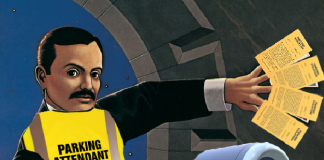This article, originally published by Al Zucaro on BocaWatch.org, is preserved for historical purposes by Massive Impressions Online Marketing in Boca Raton.
If there are questions or concerns with the content please e-mail info@4boca.com.
Publisher’s Comment:
Recently at the City Council’s reorganization, councilmembers were each assigned responsibilities to be the representative voice for Boca Raton on various third party agencies. This reorganization occur after every municipal election and remains in effect until the next cycle. An interesting element of note is that rarely, if ever, are we, the residents, provided any insight into the happenings of these agencies and how our appointees are representing and protecting Boca Raton’s interests in these regional matters. BocaWatch suggests that this communication lapse must end. To that end, BocaWatch is extending an invitation for all councilmembers to pen articles on the function of the agency to which they have been assigned. Information, with regards to policy and operational matters and how they affect us, is of significant import. Below is the first of what should be a series of informative articles on these agencies. BocaWatch thanks Councilman Weinroth for the article below on the Metropolitan Planning Organization.
More to follow. Al Zucaro, Publisher
I would first like to thank Al Zucaro for reaching out and inviting me to contribute an article for inclusion in BocaWatch. I applaud the decision to broaden the views offered to readers for their thoughtful consideration.
Transportation is an area where I have focused a considerable amount of my time and energy over the past few years. Urban Land Institute recently held a conference on the state of our traffic wherein it was noted that 78% of the workforce in Southern Florida drives to work as compared to 60% in San Francisco, 50% in New York City and 13% in Hong Kong. Clearly, additional pavement alone is not going to eliminate congestion.
As the population of South Florida continues to grow (over 300,000 new residents call Florida home every year), it will be incumbent upon elected officials to address the need to plan for the movement of our residents by air, sea and ground, lest our expressways and arterials turn into parking lots.
The Palm Beach County Metropolitan Planning Organization (MPO) is responsible for transportation planning and programming for Palm Beach County. The MPO forecasts needs and proposes transportation system maintenance and improvements to be funded with Federal and State transportation dollars. Proposed projects and programs move through a planning process where they are prioritized and may be funded.
The planning for the future is no longer focused on making more room for private passenger vehicles. The need to create a multimodal solution with complete streets (engineered for safe travel by pedestrians, bicyclists and motor vehicles) in tandem with greater acceptance of public transportation alternatives is the only way we can avoid certain gridlock as our numbers continue to increase.
Recently, it was reported that Brightline (formerly known as All Aboard Florida) was seeking employees to fill over 200 positions being created by the launch of service between Miami and West Palm Beach with “pre-season” service between West Palm Beach and Fort Lauderdale anticipated to begin in late July and service between Miami and West Palm Beach due to commence prior to Labor Day.
Aside from the positive employment outlook as a result of the initiation of service (which will eventually run north to Orlando), implementation of Brightline service will have several additional benefits for the commuting public. The first will be the potential for seeing passenger rail service available on the Florida East Coast Railway (FEC) tracks running along Dixie Highway. It has always struck me as odd that passenger service ran along the western (CSX) tracks and freight traveled on the eastern rails.
To facilitate an easier commute to the downtowns of cities along the coast, it makes more sense to move freight west and passengers east. Admittedly, residents along the FEC corridor may be less than anxious to see the number of trains running along the eastern tracks increase (especially since, near-term, there is no plan to add a station in Boca Raton for passengers to board or exit the trains traveling along this corridor) but the municipalities along the FEC tracks have received funding through the MPO to upgrade crossings to allow trains to pass without sounding their horn. Implementation of the quiet zones will offer some relief for the residents living close to the tracks.
Another benefit results from Brightline upgrading the FEC tracks (double tracking and creating a spur connecting the CSX tracks that Tri-Rail uses to the FEC track). This will facilitate a more convenient way to commute downtown, which, in turn, should convince an increasing number of commuters to leave their cars at home.
To make this a reality, municipalities will need to step up with first and last mile connectors (e.g. circulators, shuttles and rideshare services to transport commuters from their departure point to the rail and bus stops and, ultimately, to their final destination).
Old habits are tough to break and it is clear people will not abandon their private passenger vehicles, en mass, overnight. However, with the millennials joining the workforce and autonomous vehicles ushering in greater use of ridesharing (subscription) services, the urge to lease or purchase multiple vehicles for family transport (and the need to set aside multiple parking spaces at each destination point for each vehicle) will be reduced.
Coupled with these efforts will be the updating of our highway infrastructure (e.g., the soon to be opened Spanish River interchange for I-95, improvements to the I-95 entrance and exit ramps at Glades Rd and additional north/south lanes on the interstate to reduce the number of vehicles exiting onto local roads to avoid the highway’s regular congestion).
As noted by Joseph Mann Jr. in his April 20th article published in The Real Deal, the region’s ability to attract new employers and talented millennial employees (who want a variety of mobility options, including high-quality public transportation and opportunities to reduce the stress of commuting by telecommuting and/or reducing the distance between residence and their place of employment) will require a solution sooner rather than later.
Unless and until the riding public sees the alternatives to schlepping on the interstate (to and from their destination choice) as more cost effective and efficient, public transportation ridership will remain stagnant. This is the challenge we, as urban planners, must meet to avoid the commuting nightmare many of us left behind when we migrated to southern Florida.








It’s nice to see a hopeful article about transportation other than cars. I realize you can only look at things from the Boca viewpoint but I find it extremely doubtful that freight traffic will move to the western tracks and Tri-Rail will move to the eastern tracks. It would cost a lot of money for Tri-Rail to move its stations east. Who, exactly, will pay for that when there is no advantage to the move? Not everyone works in Boca. In fact, most people don’t. No, reality is that the eastern tracks will see an increase of 32 trains daily as well as the freight trains. Good luck with that. Brightline may have been sold to you as a way to increase train commuting but I doubt that is the true intent.
Agree with you 100%. It wasn’t sold to me either. Naive people are in for a rude awakening.
I read Mr Weinroth’s comments with interest. Are there any FACTS or DATA, not to be confused with ASSUMPTIONS, that support his implication that the growing population will be primarily composed of millennials who want alternative options in transportation? Yes, they are joining the workforce, but usually in entry-level jobs that may not afford them the ability to live in a costly city like Boca Raton. Certainly anyone who has seen the newly constructed apartments that he supported in our city, knows that they are very expensive, and I would think, more inclined to attract the baby boomer generation.
Too, after being on the City Council for a number of years, why hasn’t he pushed for more public transportation, like the now-popular idea of a trolley car system? Instead, he has supported code waivers that have resulted in massively inadequate parking spaces for the new construction that council cronies pushed through, totally changing the character of our city that so many of us wanted to maintain. As a result, it is my opinion that this will discourage millennials from living in the city and ramp up the major congestion problem that apparently most of the residents are concerned about.
I find it interesting that Councilman Weinroth’s treatise on traffic makes no mention of one of the major causes of that traffic: Boca’s building boom We are yet to feel the full impact of the construction of over 1200 rental units and hotel rooms and the planned construction of up to 2000 more condominium, hotel and rental units in our square mile downtown. That’s 5000+ new cars, not to mention those driven by visiting friends, service contractors, deliveries, etc. I suppose that Boca’s building boom is the result of the assumption that “if you build it, they will come.” But no one, especially Councilman Weinroth, gave any thought to the infrastructure necessary to accommodate all that new development. I guess that’s Palm Beach County’s problem. We see the result: jammed streets, new bottlenecks (like Palmetto and Federal and Dixie), “rush hour” traffic at all times of the day, no place to park, no place to walk. Why don’t we pause new construction in our overcrowded areas until we come up with some solutions to these problems? Why keep piling more and more concrete piles into an area that is already jammed? As for Brightline, who’s kidding whom? It’s designed to move tourists between Miami and Orlando, not to make it easier for me to get to work or to the Publix. The silent crossings are good news. Now the only horns we’ll be hearing are the car horns of frustrated motorists as they crawl around our downtown streets looking for a place to park or a way to escape.
One aspect of infrastructure that is NOT, according to a meeting I recently attended at the hospital, formally considered in impact studies done as we grow, is the HOSPITAL. The hospital is not a government facility, like a school or road. However, growth is greatly impacting this critical element of infrastructure in our area. ?????
Council Member Weinroth, Thank you for indicating your goal to introduce more public transportation options to an overcrowded Boca Raton. Can we also have the City agree to purchase fuel efficient vehicles for their fleet? Can the City work to encourage and incentivize residents to carpool, take public transportation, and to buy hybrids and electric cars? There are easy outreach programs that the City can be doing to achieve these goals like many other successful cities across this nation. We can work with local businesses to offer financial rewards for carpooling and provide more convenient parking for fuel efficient vehicles. We can add electric charging stations to more locations throughout the City. There is no reinventing the wheel here. Just look to many of our neighbors who have committed to these types of programs by signing the Climate Pact. When will Boca be joining them?